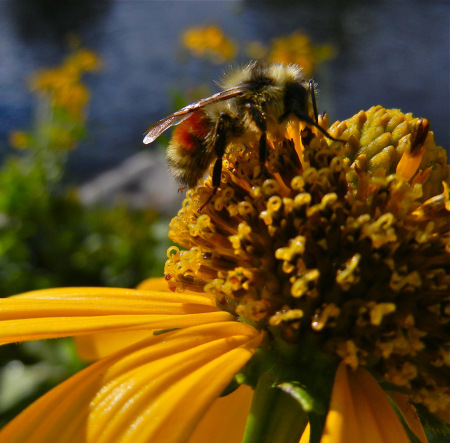Go to the broadcast section of our main site at Renewable Now. biz to find great segments on this. Protecting bees is a huge environmental/economic issue for the world. Yes, each agency, and we, the people, need to fully support their safe keeping and habitat.
Report says EPA, USDA must do more to protect wild bees
by Bob Berwyn

GAO report says EPA can do more to protect native bees from pesticides.
Staff Report
U.S. government investigators said the EPA and the Department of Agriculture need to take more steps to address threats to wild bee populations, starting with a better monitoring program to assess the impacts of agricultural pesticides.
According to a new report from the Government Accountability Office, the USDA has failed to live up to a May 2015 mandate from the White House to monitor the health of native bee colonies. North America is home to more than 4,000 species of native bees.
“Native bees pollinate about 80 percent of flowering plants around the world, including valuable food crops like blueberries,” said Lori Ann Burd, environmental health director at the Center for Biological Diversity, a watchdog group that’s been highly critical of the federal government’s failure to adequately address the impacts of pesticides on pollinators. “This report sends a clear signal that the agency has to buckle down right away and start to do the important work of protecting our native bees,” Burd said.
Pesticides are suspected to be one of the primary causes of pollinator population declines. The GAO report said the EPA should be a better job of working with other agencies to assess how pesticide cocktails are affecting bees, considering that fields are sometimes treated with dozens of different pesticides at any given time.
“By identifying the pesticide mixtures that farmers most commonly use on crops, EPA would have greater assurance that it could assess those mixtures to determine whether they pose greater risks than the sum of the risks posed by individual pesticides,” the GAO wrote in its report.
“For far too long, the EPA has turned a blind eye to the impacts of pesticide mixtures,” said Burd. “I hope this report will force the agency to finally take the common-sense measure of studying the effects of pesticides in real-world conditions, where multiple pesticides are present, rather than just in sterile laboratories, where only one pesticide is tested at a time.”
Mixed together pesticides can act synergistically to kill or severely harm bees and other nontarget animals like fish and birds.
In formal comments on the report, the USDA and the EPA said they agreed in large part with the recommendations and explained that the agencies have already been working on addressing some of the issues identified by the GAO.
The USDA said that implementing many of the suggestions would require additional funding.

No comments:
Post a Comment